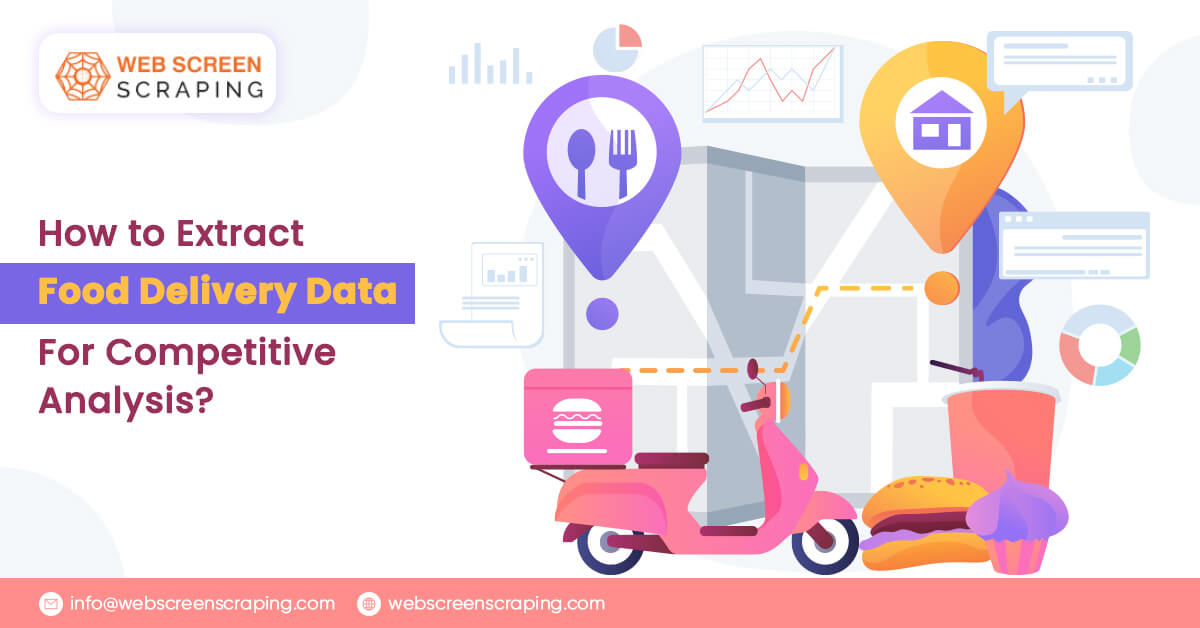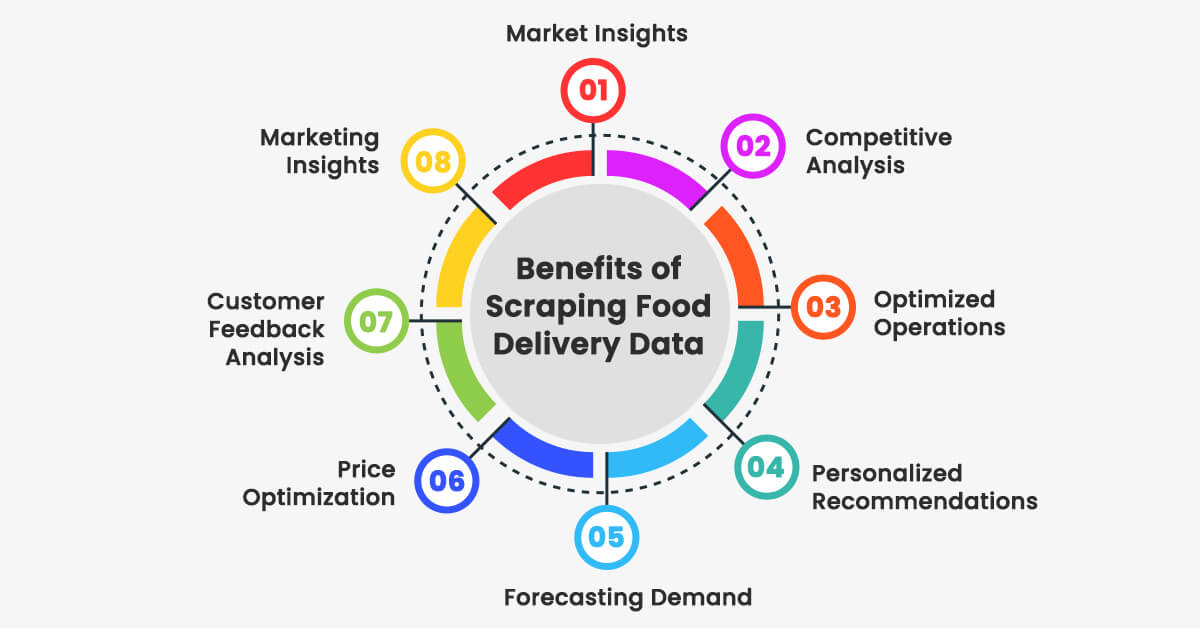
Extracting food delivery data is an obvious choice for businesses with access to this service and are interested in learning more. The data can offer insightful knowledge about demand, customer preferences and behaviors, and other essential details to give an advantage over competitors. Business owners may benefit from this kind of information when trying to improve their products and services. It's the best tool for developing pricing and marketing plans to stay competitive.
Understanding Key Statistics
It might be laborious and time-consuming to browse every competitor's platform and review all the data they collect and adhere to. Going through all of this data without the aid of the right technology is nearly impossible. The online meal delivery market is expected to generate around $192 billion in sales by 2025, up from an estimated $127 billion at the end of 2021. Millions of users utilize these platforms and applications, including hundreds of restaurant listings.
Chains and restaurants serving food are using analytics and big data to understand their customer's tastes and preferences. Web data extraction services help get data from apps like UberEats, Zomato, Swiggy, etc., for better marketing strategies, price adjustments, etc. Food delivery data extraction is the answer to assist you in achieving your goals if you want to improve your restaurant or food delivery business.
What is Food Delivery Data Scraping?
Data extraction is the process of obtaining a large quantity of data from any specific website or application. Given the intense rivalry in the hospitality industry, food delivery platforms, and similar fields, food enterprises must promptly leverage the data to their advantage. Information such as delivery routes, meal preparation times, and other details might help you stand out from the competition and provide better services.
Before diving into the extraction process, it's essential to understand the types of data available in the food delivery realm. This can include
Order Data
This pertains to every single detail of every order that is placed with the delivery provider. It contains the items the consumer requested, the quantity they ordered, and the order placement date. Consider it a log of what, when, and how much individuals purchase. It also often contains the customer's name and contact information, enabling firms to personalize their offerings.
Delivery Data
This category of data is devoted to the delivery aspect of the subject. It helps delivery drivers determine the most effective routes by informing us where the food is delivered. It also provides information on how long deliveries take and if they arrive at the scheduled times. Sometimes, it even contains information on the delivery person, such as their route or client testimonials.
Menu Data
The information about the menu items that are available for delivery is quite helpful. It provides descriptions of every dish so that customers are aware of what to expect. Pricing are also included, which enables companies to modify their pricing in response to variables like competition and demand. Additionally, you may find additional information that enhances the openness of the ordering process, such as nutritional data or user feedback.
Customer Data
Customer Data It provides information on the individuals placing food orders. It may contain details on their age, gender, and place of residence. This aids companies in better understanding their clientele and developing targeted marketing campaigns. It also keeps track of how frequently customers order, what they typically get, and any feedback they may provide. This aids companies in identifying patterns and enhancing their offerings to maintain client satisfaction.
How to Identify Data Sources?
Combining different data sets gives organizations a comprehensive understanding of their client base and the performance of their delivery business with food data scraping services. This aids in their decision-making, enhances customer service, and ensures customers return for more delicious meals!
Custom Databases
Some companies have dedicated databases set up, especially for information on food delivery. Because these databases are customized to meet the unique requirements of the company, it is simple to save and locate the correct data. They may contain any kind of data, such as menus, client information, and details on orders and delivery. Custom databases are a valuable tool for firms to handle their data effectively.
Web scraping
Official routes such as APIs may not always provide the data you want. This is the use of web scraping. It's a method for directly extracting data from web pages. Businesses can obtain information such as menu items, pricing, and customer evaluations by "scraping" the appropriate websites. Nonetheless, online scraping may be challenging, so companies must exercise caution when it comes to things like website updates and legal issues.
Benefits of Scraping Food Delivery Data

Data on food delivery may benefit company owners in various ways. It enables business owners to modify their tactics to contend in the dynamic meal delivery industry. Data is the foundation for creating a solid plan when businesses scrape food delivery data that will lead to corporate success. Using a scraping API and food data scraping services makes gathering and updating this data in real time possible. The knowledgeable are more likely to take over the sector one delivery at a time since knowledge truly is power.
Let’s understand the benefits of scraping food delivery data
Market Insights
Scraping data means collecting information about what people order from food delivery apps. This helps businesses understand what types of food are popular in different areas, what dishes people like the most, and when they order the most. With this info, businesses can adjust their menus and advertising to match what customers want.
Competitive Analysis
By looking at what other restaurants are doing—like how they set prices or advertise—businesses can figure out how to compete better. They can see what works for others and try similar things or find gaps in the market they can fill.
Optimized Operations
Knowing when and where people order food helps businesses plan better. They can ensure they have enough staff and ingredients at busy times so customers don't have to wait long for their food.
Personalized Recommendations
Food delivery apps can use the data they collect to suggest meals that customers might like based on what they've ordered before. This makes customers happier because they get suggestions that match their tastes.
Forecasting Demand
Businesses can predict when they'll be busiest by looking at past orders and other factors like weather or holidays. This helps them plan ahead and be ready for future opportunities by leveraging food data scraping services.
Price Optimization
Seeing what other places charge for similar food helps businesses decide how much to charge while still making money. They can adjust their prices to stay competitive with web scraping food delivery data.
Customer Feedback Analysis
Reviews and ratings left by customers tell businesses what they're doing well and where they can improve their products and services. This helps businesses make changes to keep customers happy and satisfied.
Marketing Insights
By seeing how people respond to ads and promotions, businesses can figure out what works and what doesn't. This helps them spend their advertising budget more wisely on the segments that helps them to convert the expenses into actionable leads.
Best Practices for Scraping Food Delivery Data
Web scraping food delivery data can be impactful for businesses because it helps inform decision-making and capture market share. By following the best practices, you can conduct food delivery data scraping in a manner that is respectful, efficient, and legally compliant. There are several practices that help in web scraping food delivery data for better business operations:Respect Terms of Service (ToS)
Every website or platform has terms of service that users must follow. When scraping food delivery data, it's crucial to review and adhere to these terms. Violating them could lead to legal issues or getting banned from accessing the platform.
Use API when Available
Many platforms provide APIs (Application Programming Interfaces) to allow developers to access data in a structured and efficient way. Using the official API ensures that you're accessing data in a manner approved by the platform, with proper authentication and rate limits in place.
Follow Robots.txt Guidelines
The robots.txt file on a website tells web crawlers which pages they can or cannot access. Respecting these guidelines is important to avoid legal consequences or being blocked from accessing the website.
Avoid Overloading Servers
Sending too many requests to a website's servers in a short period can overload them, leading to slower performance or even crashing the site. It's essential to pace your scraping activities and avoid placing excessive load on the servers.
Use Proxies and Rotate IP Addresses
To prevent being detected as a scraper and potentially getting blocked, consider using proxies to hide your IP address or rotating IP addresses to distribute requests across different addresses.
Set Proper Headers
Including appropriate headers in your HTTP requests, such as user-agent strings, helps mimic the behavior of a regular web browser. This can prevent detection as a scraper and improve the success rate of your scraping efforts.
Respect Rate Limits
Many platforms impose rate limits on API requests to prevent abuse and ensure fair access to resources. Adhering to these rate limits is crucial to avoid being throttled or banned from accessing the API.
Handle Errors Effectively
Errors can occur during the scraping process due to various reasons, such as network issues or changes in website structure. Implementing error-handling mechanisms ensures that your scraping script can recover from errors and continue running smoothly.
Monitor and Adjust
Continuously monitoring your scraping activities allows you to adapt to any changes on the website, such as updates to the terms of service or rate limits. Adjust your scraping strategy accordingly to maintain effectiveness and compliance.
Data Privacy and Security
When performing web scraping food delivery data, it's important to handle the collected data responsibly and in compliance with data privacy regulations. Take measures to protect the security of the data, such as encrypting sensitive information and securely storing it.
Conclusion
Web screen scraping provides a hassle-free solution for companies looking to extract data from websites without the need for hiring a development team or mastering programming languages. Our plug-and-play system can be set up in just minutes, saving you time and effort.
With Web Screen Scraping, you can easily scrape food delivery data without dealing with:
- Proxy management and rotation.
- Complicated output formats.
- CAPTCHAs and other anti-scraping measures.
- JavaScript rendering.
- Coding modules.
Our platform also comes with comprehensive documentation to help you quickly learn how to use it and explore all the possibilities it offers.

